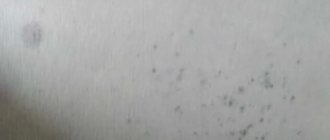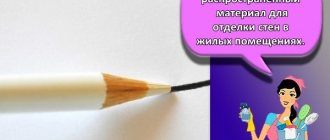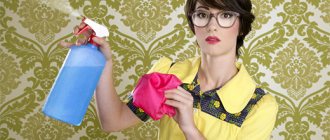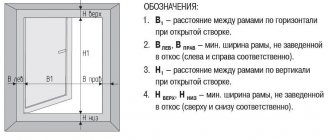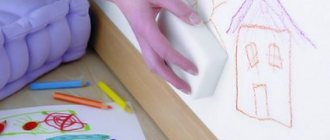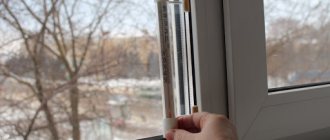Ask your friends about when you can open windows after wallpapering, and you will hear diametrically opposed opinions. Some will say that you need to wait almost a week just to be sure, while others will even admit that they left the windows open even while gluing, and nothing bad happened. So where is the truth? And in general, where did this repair belief come from that windows must be kept closed?
Open windows when wallpapering or close them
If the conversation turns to whether it is possible to glue wallpaper with an open window in the summer, then the opinions of craftsmen often differ.
To clarify, it is necessary to understand the reasons given by people who advocate that the room should not be ventilated during work and after work at any time of the year. Below are several arguments in this regard.
- Drying of the canvases should occur evenly and gradually. If the windows are open, the wallpaper will not be able to dry. You should also not use various fans and other devices. The adhesive solution should be well saturated and create a tight connection. Air can speed up the process, but this will be at the expense of reliability.
- Sudden temperature changes should be avoided. This is especially true for paper canvases. If temperature changes were nevertheless allowed, then after drying, mold will most likely grow on the products.
- Due to the cold air flow, the coating will begin to deteriorate and adhere incorrectly. Bubbles may also form between the wall and the wallpaper.
Such disputes began to arise after products made from cellulose began to become popular. Paper coverings are indeed unstable to moisture and are afraid of temperature changes.
Currently, you can find vinyl or non-woven fabrics on sale, which are in no way inferior to those made on a cellulose basis, and were especially popular several decades ago.
Some products made from non-woven material such as non-woven fabric may still not tolerate sudden changes in room temperature up or down. In this regard, before purchasing, it is worth checking the characteristics of the wallpaper with the seller.
Despite the fact that non-woven fabrics take longer to dry than paper ones, they come off much less often. Usually the cause of problems with this type of wallpaper is improper work, and not drying of the material.
Many people are interested in how long windows should not be torn off when this coating has been glued. According to the recommendations of experts, air flows should not penetrate into the room for another 48 hours after the work is completed.
The reasons for the main rule of wallpapering
To understand why you can’t open windows, you should start with the reasons for this ban. The issue with air flow after gluing products arose because previously only paper coatings were on sale.
The technology for gluing them is quite simple, but high-quality results have not been achieved very often.
This is due to the fact that when you glue wallpaper, drying should occur gradually and be evenly distributed over the entire surface.
When the window was opened immediately after the work was completed, a draft appeared. Because of it, folds and air bubbles appeared on the wallpaper, as well as other types of deformation of the products.
Although there is now a large selection of canvases made from other materials on sale, professionals still strongly do not recommend opening the windows when working with them until everything is dry. Whether windows can be opened is also influenced by other, no less important, factors.
What not to do
- Accelerate drying artificially using heating devices or heaters. Hot air currents will accelerate the evaporation of moisture from the adhesive and the wallpaper will begin to peel off. The operating principle of heaters is based on the movement of air masses, so uneven drying is guaranteed.
- Air cooling by air conditioners. The thermal regime for normal drying will be disrupted.
- During the drying period, any work in the room is excluded. This is especially true for work where heating devices are even used locally, because the heat balance will still change in the entire room. You can't drill into the walls either, as this can ruin the finish.
After gluing the canvases from the glue, the moisture will gradually begin to evaporate and it will become stuffy. This is normal and will not affect drying. On the contrary, the evaporated moisture will saturate the wallpaper and drying will be more even.
How long does it take for wallpaper to dry?
The question of how long it takes to open windows when the work has been completed is quite often found on various forums or arises among those new to wallpapering.
The duration of drying of the canvases depends on the material from which they were made. On average, you need to wait about a day before opening the windows. Depending on the type of coverage, the duration may vary up or down.
Paper wallpaper
These fabrics are considered to be the fastest drying ones. However, you should not try to speed up the process by using special devices in the form of fans, etc.
Such equipment will only ruin the wallpaper and the work that was done to glue it.
Another important point is that it is forbidden to act with open windows or open them ahead of schedule. The approximate drying time for such products is 13-14 hours. This is the minimum time, sometimes a little more may be needed.
Non-woven wallpaper
If this type of painting was chosen for the wall, then the residents will have to stay in the stuffy room for a long time after the work is completed.
After gluing non-woven wallpaper, it is recommended to leave the apartment for several days or live in the next room, if conditions allow.
The exact drying time depends on the fabric manufacturer. On average, it can take 2 to 3 days for products to dry.
Vinyl wallpapers
This type of wall covering material takes the longest to dry. They are prohibited from being glued with open windows, and the minimum drying period starts from 24 hours. In reality, one day is rarely enough.
On average, complete drying of vinyl-based products occurs only after 3 or 4 days.
What about non-woven, vinyl
Vinyl or non-woven wallpaper is multi-layered, the top of which is not saturated with glue. Therefore they are not so demanding.
The bottom layer of non-woven fabric, glued to the wall, is protected by the top vinyl or the same non-woven fabric. This means that minimal drafts are harmless. But still, regardless of the base of the canvases, it is always recommended to keep the windows closed until the end of drying.
Peeling of trellises or the formation of bubbles on non-woven sheets is usually associated with a violation of the gluing technology.
Sushi will take longer.
It is advisable not to open the windows for about 5 days. But light ventilation is allowed after 24 hours.
Glue drying period
Another important point in this type of repair work is the adhesive composition. The duration of drying of the canvas partly depends on it.
Nowadays, in construction retail outlets or through online stores you can find solutions that are quick-drying.
But even such adhesive masses require that after application they be left alone for a couple of days. The exact drying time of the adhesive mixture depends not only on the type, but also on the microclimate of the room.
Do not use electrical devices for heating or ventilation during the drying stage. They can only ruin the canvas, but will not speed up the process in any way.
From the video below, readers of the article will understand in more detail whether windows need to be closed and after what time period they can be opened.
Is it possible to enter the room
The doors inside the room do not need to be kept closed for 24 hours. Only a specific room requires tight shutters for door and window openings. In other rooms, elements that are wide open will be useful, even necessary. The temperature will change, but such adjustments will not be enough to worsen the result.
The stripes are damaged only by strong drafts and winds that continued to blow for several hours. Therefore, it is still necessary to close the structures. Non-woven wallpapers are more vulnerable to the environment, so extreme care is taken with them.
Floor and ceiling skirting boards will help you cope if problems do arise. If you choose the right shades, they will not only support the structures, but also decorate the appearance of the room.
Requirements for the room microclimate
The optimal air temperature in the room where gluing of sheets is carried out varies between 16-19 degrees.
But such figures do not mean that there must be an air conditioner indoors that can control the climate.
Even if it is more than 20 degrees in an apartment or private house, this will not interfere with the normal drying of the products. The drying time depends on the temperature. The closer it is to optimal, the faster you can open windows.
Indoor humidity is also important. The moisture level should not exceed 62%. You can check the humidity in a room using a device such as a psychrometer. If suddenly the device shows numbers much higher than those mentioned above, you will have to postpone work for several days until the indicator gets closer to normal.
Low humidity is also not suitable for gluing canvases to the wall. Insufficient moisture has a bad effect on the adhesive mass, because its water part evaporates very quickly.
If the humidity in the room is low, the situation can be corrected with a spray bottle. This device should distribute water along the walls.
During the summer season and the heat, there are also specific features of wallpapering. For example, the glue needs to be protected from drying out while it is still wet.
Thick curtains or paper to cover the windows can help with this. Dark-colored materials should not be used for these purposes. Such products will absorb heat, thereby heating the room even more.
What can you do while drying wallpaper?
The actions of a person who lives in a room where wallpaper was hung are limited for the first few days. In addition to the fact that it is not recommended to open windows, you should also not enter the room often.
This is due to the fact that when the door is in the closed position, it prevents air masses from entering. But the entrance structures of the remaining rooms can be opened as much as you like.
But still, it’s better to play it safe a little and not touch the room where the repair work was carried out for a while. Sometimes it is prudent to live for a couple of days in another house or with friends, especially if the apartment is one-room.
To prevent various problems from arising during the drying process, the following things are prohibited:
- allow drafts in the apartment, regardless of what time of year it is outside;
- include devices such as a fan, air conditioner and the list goes on;
- change the temperature conditions inside the room.
Heating lighting can only be used when it is necessary to speed up the adhesion between the wallpaper and the wall.
It is also important to remove various traces from the surface of the structure before gluing the canvases onto it. For example, you need to get rid of:
- old enamel and primer layer;
- remnants of the adhesive base from previous products;
- the wallpaper itself, if it was previously used as a facing material.
In addition, you don’t have to worry about the wallpaper drying out during the warm season. If the weather outside is good, then as soon as the above-mentioned drying period has passed, the windows can be opened.
If suddenly bubbles do appear in the products, then they can be eliminated in several ways. The most common and effective method is carried out using the following technology:
- Take a syringe and fill it with adhesive mass.
- Use a needle to pierce the air bubble.
- Introduce the mixture in this place, pressing the canvas with your hand.
This method works in cases where the main adhesive solution has already hardened.
Where did this rule come from?
The ban on open windows is a truism that is rarely questioned. But in vain. Not all people turn to repair teams to hang wallpaper, and not everyone will even look for information on the topic on the Internet. That is why we often rely on the experience of the older generation, who are confident: it is enough to close the door abruptly, creating a draft, and the half-dry wallpaper will certainly end up on the floor. But is this really so?
A couple of decades ago, few people had heard of non-woven or vinyl, and the wallpaper in the apartments of 99% of the population was, naturally, paper-based. It was not difficult to glue them, but there was one caveat: the paper wallpaper had to dry evenly and slowly, since drying in patches led to deformation of the canvas, bubbles, wrinkling, and even partial or complete peeling from the wall. An open window created a temperature difference and a draft that dried the canvas unevenly, which is why it was so important to close it. Now it’s clear why it was believed for a long time that the slightest draft could completely ruin the fruits of your efforts.
By the way
It has always been believed that when covering walls, the window should remain closed, and this is still true: despite some positive experiments, an open window can interfere with the drying process, regardless of the type of wallpaper you use.
Preparing walls before wallpapering
Before wallpapering begins, the walls are leveled using putty. This material not only levels surfaces, but also removes depressions, crevices, etc.
Without this process, it is unlikely that the canvas will be properly glued. Most products do not hide unevenness well, so the wallpaper can not only become deformed, but also have an unpresentable appearance.
In addition, various debris needs to be removed from the walls: dirt, dust, remnants of the old coating, etc. This work can sometimes be done using a vacuum cleaner.
You can check how clean the surface is after such work using adhesive tape. It sticks to the wall and then immediately comes off. If particles of debris remain on it, then the coating will have to be cleaned more thoroughly; if not, then you can move on to the next stage of preparation.
To make the connection more reliable, the structures are treated with a special primer. It also needs to be given some time to dry. It is important to use these tools for the following reasons:
- the base for the wall will be stronger;
- surfaces made of different materials will become homogeneous, thanks to which the composition can be distributed evenly and the adhesion will be the same in all places;
- improved adhesion.
How to prepare the wall surface
If you are not moving into a new apartment, where you need to cover the walls from scratch, but are doing a major renovation, then you need to thoroughly clean the walls of the old coating (wallpaper, glue or paint).
The walls must be perfectly plastered so that there are no depressions or bumps. Then you need to apply a primer to them. To do this, dilute the adhesives and coat the entire surface from floor to ceiling with it. If you do not thoroughly prepare the surface, the sheets may come off along the edges at the joints or in the middle of the sheet, or even throughout the entire sheet.
Wallpaper is easier to stick to a prepared wall
How to check the condition of the wall? Take electrical tape, stick it anywhere and remove it. If it comes off easily and you see various small particles on it, then the surface needs to be thoroughly cleaned.
Prime the entire surface well, and it makes sense to sand the final layer of putty with coarse sandpaper. Then even heavy vinyl or non-woven wallpaper will easily lie on the surface and be securely glued to it.
When to open the window
The question of ventilation after finishing the work process worries many. However, it is impossible to find a definite answer to it. Each case is individual and depends on many nuances, from the temperature of the room to the material of the canvases themselves.
Manufacturers give the following recommendations about how long windows are allowed to open:
- It will take 13 hours for paper products to dry. If they are used for enamel application, then a couple more hours are added to the drying time. The best option is to leave the room without air flow for 24 hours.
- If non-woven fabrics have been glued, they need to dry for a couple of days.
- Vinyl products require the longest drying time, which can sometimes even take up to 4 days or more.
Too cold a room environment will negatively affect the adhesive composition, interfering with normal adhesion. If the temperature is high, then there is a possibility of bubbles appearing between the wall and the facing coating.
When the climate is such that the room temperature is more than 32 degrees, the work process is postponed until it normalizes. It is worth recalling that the most suitable temperature is about 17 degrees.
Other work processes cannot be started until the drying of the wallpaper is completely completed. It is especially not worth installing suspended ceilings, which significantly change the temperature in the positive direction.
Rules for drying non-woven and vinyl-based wallpaper
Compared to paper, such materials are denser. Accordingly, they will take longer to dry. If these rules are neglected, the result of the work may be far from ideal.
These materials are resistant to moisture and absorb it rather poorly. That's why the glue works slower. Also, vinyl and non-woven products are quite heavy, and therefore the canvases require more adhesive solution.
The adhesion compound is applied to the wall using a brush or roller, only then the wallpaper is glued.
The outer layer of these materials dries faster than what is inside. Therefore, the products are little susceptible to small temperature changes.
What do you need to glue wallpaper?
Remember! The layer of glue on the canvas should be about 2 mm - it will be saturated with glue, but will not get wet. It is better to apply glue on the wall wider than the canvas - the edges of the wallpaper
They will stick exactly and will not lag behind the surface.
Hanging wallpaper
alone is a disastrous task, unless, of course, you are a superhero, so find yourself a partner.
Interesting materials:
How to connect 2 computers to one network cable? How to connect 2 pairs of AirPods to Apple TV? How to connect 2 pairs of headphones to iPhone? How to connect 3 GB to Rostelecom? How to add 3 months of subscription to ps4? How to connect 3D Secure Belinvestbank? How to connect 3D Secure in Sberbank? How to connect 4 channels to a sub? How to connect a 4 channel amplifier with a bridge? How to connect 4ji Kyivstar?
Let's sum it up
After reading the article, it is easy to answer the common question about what kind of wallpaper can be glued to the wall if the windows are open. In such a situation, no canvases can be glued, regardless of their material.
After the topic of how long windows should not be opened has been learned, it is important not to forget all the nuances, namely: wait until the products are completely dry, do not start other repair work, avoid drafts and follow other recommendations and rules discussed in this article.
Following the advice of experts, you will be able to glue the wallpaper securely and firmly. But if you have doubts about whether you can do such work yourself, you can always turn to professionals for help. However, in this case, you will have to spend money both on the canvases themselves and on the services of workers.
